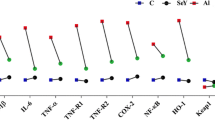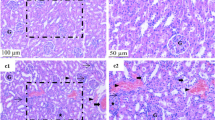Abstract
The objective of this study is to investigate the toxic effects of aluminum and the potential alleviation of selenite and N-acetylcysteine (NAC) on this toxicity. Acute aluminum toxicity was induced by intraperitoneal (i.p.) injection of AlCl3 (30 mg Al3+/kg) for four consecutive days. Al3+ damaged the synthetic capability and regeneration power of liver cells and induced inflammation. It also damaged the kidney and disturbed the lipid profile enhancing the total cholesterol level and LDL-cholesterol level increasing the risks of atherosclerosis. Al3+ reduced the cellular antioxidant milieu typified by the decrease in reduced glutathione, vitamin E, and four antioxidant enzymes and induced lipid peroxidation (LPO). Selenite at 1 mg Se/kg and NAC at 150 mg/kg injected either simultaneously with or after Al3+ mitigated most of these damaging effects probably by the virtue of scavenging the free radicals, binding aluminum and stimulating its excretion and reducing its bioavailability, bolstering the endogenous antioxidant defense systems, stabilizing the cell membrane, and preventing LPO. The beneficial effects of selenite and NAC against aluminum toxicity were also confirmed by the light and electron histopathology study. There were no significant differences between the two regimens used (protection and therapeutic) in the current study probably due to the short time of exposure, and the abrogation of Al3+ toxicity offered by selenite was better than that provided by NAC on the histopathology level.






Similar content being viewed by others
References
Greger JL (1992) Dietary and other sources of aluminium intake. Alum Biol Med 169:26–29
Wilhelm M, Passlick J, Busch T, Szydlik M, Ohnesorge FK (1989) Scalp hair as an indicator of aluminium exposure: comparison to bone and plasma. Hum Toxicol 8:5–9
Beyer LA, Greenberg G, Beck BD (2014) Evaluation of potential exposure to metals in laundered shop towels. Hum Ecol Risk Assess 20:111–136
Luo H, Liu G, Zhang R, Bai Y, Fu S, Hou Y (2014) Heavy metal recovery combined with H 2 production from artificial acid mine drainage using the microbial electrolysis cell. J Hazard Mater 270:153–159
Cheng D, Zhu C, Wang C, Xu H, Cao J, Jiang W (2014) Hepatoprotective effects of apple polyphenol extract on aluminum-induced liver oxidative stress in the rat. Can J Physiol Pharmacol 92:109–116
Gorozhanskaia ÉG, Sviridova SP, Dobrovol’skaia MM, Zybrikhina GN, Kashnia S (2012) Selenium and oxidative stress in cancer patients. Biomed Khim 59:550–562
Anand R, Sharma DR, Verma D, Bhalla A, Gill KD, Singh S (2013) Mitochondrial electron transport chain complexes, catalase and markers of oxidative stress in platelets of patients with severe aluminum phosphide poisoning. Hum Exp Toxicol 32:807–816
El-Sayed WM, Aboul-Fadl T, Lamb JG, Roberts JC, Franklin MR (2006) Acute effects of novel selenazolidines on murine chemoprotective enzymes. Chem Biol Interact 162:31–42
Sharma S, Raghuvanshi BS, Shukla S (2014) Toxic effects of lead exposure in rats: involvement of oxidative stress, genotoxic effect, and the beneficial role of N-acetylcysteine supplemented with selenium. J Environ Pathol Toxicol Oncol 33:19–32
Aruoma OI, Halliwell B, Hoey BM, Butler J (1989) The antioxidant action of N-acetylcysteine: its reaction with hydrogen peroxide, hydroxyl radical, superoxide, and hypochlorous acid. Free Radic Biol Med 6:593–597
Viezeliene D, Jansen E, Rodovicius H, Kasauskas A, Ivanov L (2011) Protective effect of selenium on aluminium-induced oxidative stress in mouse liver in vivo. Environ Toxicol Pharmacol 31:302–306
Horst A, Kolberg C, Moraes S, Riffel K, Finamor IA, Belló-Klein A, Pavanato MA, Partata WA (2014) Effect of N-acetylcysteine on the spinal-cord glutathione system and nitric-oxide metabolites in rats with neuropathic pain. Neurosci Lett 569:163–168
El-Sayed WM, Al-Kahtani MA, Abdel-Moneim AM (2011) Prophylactic and therapeutic effects of taurine against aluminum-induced acute hepatotoxicity in mice. J Hazard Mater 192:880–886
Yoshioka T, Kawada K, Shimada T, Mori M (1979) Lipid peroxidation in maternal and cord blood and protective mechanism against activated-oxygen toxicity in the blood. Am J Obstet Gynecol 135:372–376
Beutler E, Kelly BM (1963) The effect of sodium nitrite on red cell GSH. Cell. Mol Life Sci 19:96–97
Aebi H (1984) Catalase in vitro. Methods Enzymol 105:121–126
Paglia DE, Valentine WN (1967) Studies on the quantitative and qualitative characterization of erythrocyte glutathione peroxidase. Transl Res 70:158–169
Masayasu M, Hiroshi Y (1979) A simplified assay method of superoxide dismutase activity for clinical use. Clin Chim Acta 92:337–342
Habig WH, Pabst MJ, Fleischner G, Gatmaitan Z, Arias IM, Jakoby WB (1974) The identity of glutathione S-transferase B with ligandin, a major binding protein of liver. PNAS 71:3879–3882
Smirnoff N, Cumbes QJ (1989) Hydroxyl radical scavenging activity of compatible solutes. Phytochemistry 28:1057–1060
Blois MS (1958) Antioxidant determinations by the use of a stable free radical. Nature 181:1199–1200
Kumar V, Bal A, Gill KD (2009) Aluminium-induced oxidative DNA damage recognition and cell-cycle disruption in different regions of rat brain. Toxicology 264:137–144
Periasamy VS, Athinarayanan J, Alshatwi AA (2015) Aluminum oxide nanoparticles alter cell cycle progression through CCND1 and EGR1 gene expression in human mesenchymal stem cells. Biotechnol Appl Biochem 63:320–327
Kalimeris K, Briassoulis P, Ntzouvani A, Nomikos T, Papaparaskeva K, Politi A, Batistaki C, Kostopanagiotou G (2016) N-acetylcysteine ameliorates liver injury in a rat model of intestinal ischemia reperfusion. J Surg Res 206:263–272
Nido SA, Shituleni SA, Mengistu BM, Liu Y, Khan AZ, Gan F, Kumbhar S, Huang K (2016) Effects of selenium-enriched probiotics on lipid metabolism, antioxidative status, histopathological lesions, and related gene expression in mice fed a high-fat diet. Biol Trace Elem Res 171:399–409
El-serougy E, Ahmed HH, Kamal MM, Niazy MH (2015) The neuropeptide adrenomedullin, could it be linked to renal involvement and disease activity in systemic lupus erythematosus? Egypt Rheumatol 37:19–24
Sivakumar S, Sivasubramanian J, Khatiwada CP, Manivannan J, Raja B (2013) Determination of aluminium induced metabolic changes in mice liver: a Fourier transform infrared spectroscopy study, Spectrochim. Acta Part A Mol Biomol Spectrosc 110:241–248
Liu Y, Wang Y, Walsh TR, Yi L, Zhang R, Spencer J, Doi Y, Tian G, Dong B, Huang X (2016) Emergence of plasmid-mediated colistin resistance mechanism MCR-1 in animals and human beings in China: a microbiological and molecular biological study. Lancet Infect Dis 16:161–168
Block CA, Manning HL (2002) Prevention of acute renal failure in the critically ill. Am J Respir Crit Care Med 165:320–324
Mailloux RJ, Lemire J, Appanna VD (2011) Hepatic response to aluminum toxicity: dyslipidemia and liver diseases. Exp Cell Res 317:2231–2238
Menéndez-Carreño M, Ansorena D, Milagro FI, Campión J, Martínez JA, Astiasarán I (2008) Inhibition of serum cholesterol oxidation by dietary vitamin C and selenium intake in high fat fed rats. Lipids 43:383–390
Machado JT, Iborra RT, Fusco FB, Castilho G, Pinto RS, Machado-Lima A, Nakandakare ER, Seguro AC, Shimizu MH, Catanozi S (2014) N-acetylcysteine prevents endoplasmic reticulum stress elicited in macrophages by serum albumin drawn from chronic kidney disease rats and selectively affects lipid transporters, ABCA-1 and ABCG-1. Atherosclerosis 237:343–352
Korou LM, Agrogiannis G, Koros C, Kitraki E, Vlachos IS, Tzanetakou I, Karatzas T, Pergialiotis V, Dimitroulis D, Perrea DN (2014) Impact of N-acetylcysteine and sesame oil on lipid metabolism and hypothalamic-pituitary-adrenal axis homeostasis in middle-aged hypercholesterolemic mice. Sci Rep 4:6806–6813
Nehru B, Anand P (2005) Oxidative damage following chronic aluminium exposure in adult and pup rat brains. J Trace Elem Med Biol 19:203–208
Exley C (2004) The pro-oxidant activity of aluminum. Free Radic Biol Med 36:380–387
Kerksick C, Willoughby D (2005) The antioxidant role of glutathione and N-acetyl-cysteine supplements and exercise-induced oxidative stress. J Int Soc Sports Nutr 2:38–44
Abubakar MG, Taylor A, Ferns GAA (2003) Aluminium administration is associated with enhanced hepatic oxidant stress that may be offset by dietary vitamin E in the rat. Int J Exp Pathol 84:49–54
Aslanturk A, Uzunhisarcikli M, Kalender S, Demir F (2014) Sodium selenite and vitamin E in preventing mercuric chloride induced renal toxicity in rats. Food Chem Toxicol 70:185–190
Fernández V, Vargas R, Castillo V, Cádiz N, Bastías D, Román S, Tapia G, Videla LA (2013) Reestablishment of ischemia-reperfusion liver injury by N-acetylcysteine administration prior to a preconditioning iron protocol. Sci World J 2013:1–9
Baatrup E, Ole TU, Nielsen HL, Wilsky K (1989) Mercury-selenium interactions in relation to histochemical staining of mercury in the rat liver. Histochem J 21:89–98
Funding
This research did not receive any specific grant from funding agencies in the public, commercial, or not-for-profit sectors.
Author information
Authors and Affiliations
Corresponding author
Ethics declarations
Conflict of Interest
The authors declare that they have no conflicts of interest.
Rights and permissions
About this article
Cite this article
Nour-Eldein, N.H., Hassanin, ES.A. & El-Sayed, W.M. Mitigation of Acute Aluminum Toxicity by Sodium Selenite and N-Acetylcysteine in Adult Male Rats. Biol Trace Elem Res 183, 128–137 (2018). https://doi.org/10.1007/s12011-017-1126-8
Received:
Accepted:
Published:
Issue Date:
DOI: https://doi.org/10.1007/s12011-017-1126-8




